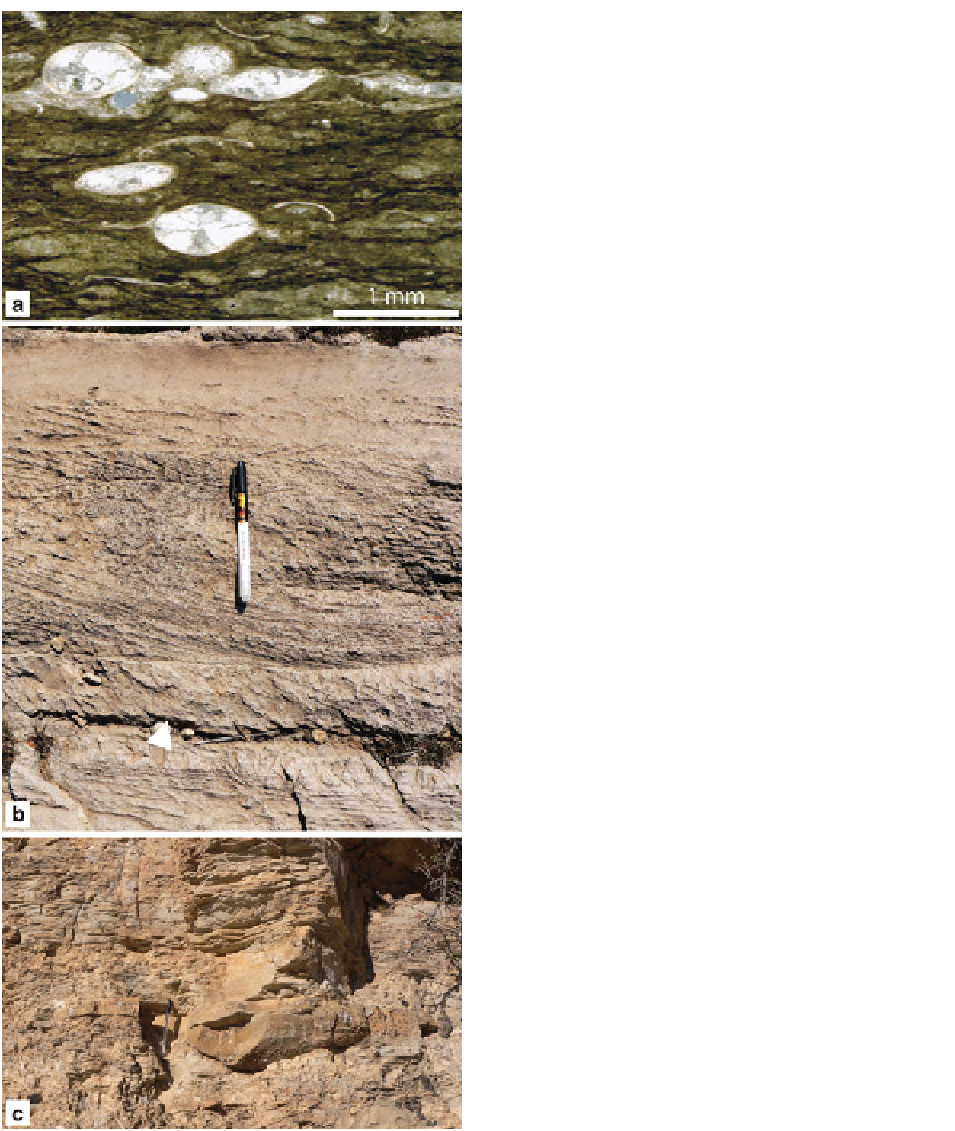Geology Reference
In-Depth Information
Fig. 21.16
(
a
) Photomicrograph of a bioturbated ostracod dolo-
mudstone with microbial laminae from an intertidal fl at sequence
interpreted as the intertidal pond facies; Mississippian Bayport
Formation, Bayport, Michigan. (
b, c
) Intertidal channel deposits
from the Middle Triassic middle member of the Elika Formation
in east central Alborz Mountains, northern Iran. (
b
) Erosive-based
fi ning-upward intertidal channel sequence (
arrow
at the erosional
contact) composed of a grainstone bed with gravel-size intraclasts
grading upward into a trough cross-bedded sand-size grainstone
that in turn grades to herringbone cross-bedded grainstone (
above
the scale
) covered by an intertidal deposit (pen for scale is 14 cm
long). (
c
) A tidal channel deposit (pen on the left side of the chan-
nel facies is 14.5 cm long) within a laminated and thin-bedded
tidal fl at succession. Note that the channel facies thins to the
right
of the photograph and pinches out completely toward the
left
facies transition and thickness patterns (e.g. Wilkinson
et al.
1997
). The random stratigraphic patterns have
been interpreted to be the result of deposition in a set
of randomly distributed environments (e.g. Wilkinson
et al.
1996,
1999
). Recent studies (e.g. Lehrmann and
Goldhammer
1999
; Lehrmann and Rankey
1999
;
Spence and Tucker
2007
) and investigation on the
Holocene carbonates of the Bahamas (Rankey
2002
) ,
on the other hand, indicate highly ordered facies
transitions in peritidal facies tracts and the resulting
vertical successions. The random facies patterns in
ancient successions may have been the consequence
of incomplete stratigraphic record and extrabasinal
forcing mechanisms (Rankey
2002
; Lehrmann and
Goldhammer
1999
) . Random vertical successions nor-
mally develop during icehouse conditions, due to unfi lled
accommodation space created by higher-frequency,
higher-amplitude sea level changes (Lehrmann and
Goldhammer
1999
; Burgess
2006
) .
21.6.1 Origin of Meter-Scale Cyclicity
Shallowing-upward cycles form when tidal fl ats
aggrade to sea level and prograde into the adjacent
subtidal setting. This is the consequence of high sedi-
mentation rate in tidal fl at areas that normally exceeds
the available accommodation space created by high-
frequency 5th- to 4th-order sea level rise. Progradation
leads to a seaward thickening wedge of tidal fl at sedi-
ments and a succession of subtidal- to intertidal- to
supratidal facies (e.g. Hardie
1986
) . Repeated deepen-
ing and fi lling of accommodation space in response to
relative sea level changes (the sum of eustatic sea level
change, subsidence and sediment supply), lead to
2007
; Catuneanu et al.
2009
), the fundamental unit of
stratigraphic sequences.
Many ancient peritidal successions, at least in part,
lack any stratal order and comprise random vertical

